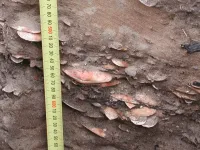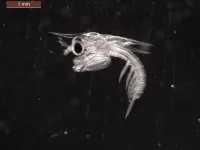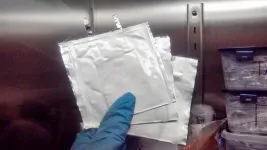(Press-News.org) The discovery of ancient kumara pits just north of Dunedin dating back to the 15th century have shone a light on how scientific evidence can complement mātauranga Maori around how and where the taonga were stored hundreds of years ago.
A new study published in the science journal PLOS ONE reports that early Polynesians once stored kumara - American sweet potato - in pits dug into sand dunes at Purākaunui, eastern Otago, less than 30km north of Dunedin. The pits were first discovered in 2001 and are found over 200km south of the currently accepted South Island limit of cooler-climate Māori kumara storage.
These Purākaunui features have the novel form of semi-subterranean, rectangular pits used for the cool seasonal storage of live kumara roots in bulk, known as rua kumara. Research into their age, contents and context has been led by Associate Professor Ian Barber of the University of Otago's Archaeology Programme with the support of university grants and a Marsden award, and the input of radiocarbon expert and co-author Professor Tom Higham of Oxford University.
The research was carried out with the approval and engagement, through successive hui, of Purākaunui Block owners and Kāti Huirapa Runaka ki Puketeraki as manawhenua.
In this historic study, statistical modelling has dated the Purākaunui pits by radiocarbon to the very tight range of 1430-1460 CE at 95% probability, making it some of the most accurate carbon dating to have taken place in New Zealand thanks to advanced technology. Researchers believe rua kumara were stored there due to the discovery of microscopic starch granules with distinctive kumara characteristics from secure deposits at the base of the pits.
The find, Polynesia's southern-most ancient kumara dicovery adds incredible weight to local Māori oral history and tradition that has been considered enigmatic if not overlooked by archaeologists. A number of these traditions refer to southern kumara loss or failure, but some reference kumara memories, atua (deities), stores and cultivations notably from the North Otago Huriawa Peninsula headland and pā less than 30km north of Purākaunui. Ancient rua kumara discovered along the same coastline represent an intriguing connection between these traditions and archaeology.
Purākaunui Block Incorporation chairperson Nicola Taylor says there is significant excitement surrounding the significant research.
"This confirms for us at Purākaunui the importance of our very long history and connection with the land," she says.
"These findings reinforce our very long association with the land and contribute to our own compilation of stories designed to capture the history for future generations."
Those sentiments were echoed by Kāti Huirapa Runaka ki Puketeraki manager Suzanne Ellison.
"Ian's research has been really interesting for the Runaka to follow & with the confirmation via carbon dating of the kumara pit at Purākaunui, it is very affirming about traditions and mātauraka relating to Huriawa Peninsula," Ellison says.
Associate Professor Barber says the study highlights the important connection between te ao Māori and traditional archaeological practices.
"We hope to have modelled respect as much as science in the engagement of Māori knowledge and archaeology," he says.
Associate Professor Barber says there are some questions that still remain about whether the stored kumara roots were imported from warmer northern localities or harvested locally in microclimate production.
"However the dark, sandy archaeological soil at Purākaunui suggests it may have been used for ancient cultivation."
In either case, this discovery represents the earliest securely dated rua kumara in Aotearoa. It joins a small number of examples of American kumara in Polynesia dated securely before explorer Christopher Columbus' navigations. He says the tight chronology also identifies and places the rua kumara storage at around the time of moa extinction, perhaps as mitigation for the loss of this valuable food source.
INFORMATION:
For more information or comments contact:
Associate Professor Ian Barber
Archaeology Programme
Tel +64 3 479 8758
Email ian.barber@otago.ac.nz
Suzanne Ellison
Manager, Kāti Huirapa Runaka ki Puketeraki
Email manager@puketeraki.nz
Nicola Taylor
Chairperson, Purākaunui Block Inc.
niccytaylor@gmail.com
The brain possesses a complex architecture of functional networks as its information-processing machinery. Is the brain's network architecture itself a target of disease? If so, which networks are associated with which diseases? What can this tell us about the underlying causes of brain disorders?
Building on the extraordinary progress in neuroscience made over the past 30 years, researchers from The University of Texas Health Science Center at San Antonio (UT Health San Antonio) published a study of 43 brain disorders - both psychiatric and neurologic - and strongly affirmed ...
EUGENE, Ore. -- April 29, 2021 -- An analysis of Twitter activity between March 1 and Aug. 1, 2020, found strong support by U.S. users for wearing face coverings and that a media focus on anti-mask opinions fueled the rhetoric of those opposed, report University of Oregon researchers.
The study, published April 28 in the journal PLOS ONE, initially focused on linguistics, zeroing in on the language associated with hashtags during the study period, which began a month before the Centers for Disease Control and Prevention recommended mask-wearing to protect against COVID-19 infection.
However, to better understand that semantics, which were found to be polarized, angry and emotionally ...
Adult mantis shrimp pack an explosive punch that can split water, but no crustacean emerges fully formed. Minute larvae can undergo six or seven transformations before emerging as fully developed adults and limbs and manoeuvres develop over time. So, when do mantis shrimp larvae acquire the ability to pulverise their dinner and how powerful are the punches that these mini crustaceans pack? 'We knew that larval mantis shrimp have these beautiful appendages; Megan Porter and Eve Robinson at the University of Hawaii had captured normal videos of a couple of strikes a few years ago', says Jacob Harrison from Duke University, USA. So, he packed up ...
Adult heterosexual women and men are often jealous about completely different threats to their relationship. These differences seem to establish themselves far sooner than people need them. The finding surprised researchers at the Norwegian University of Science and Technology (NTNU) who studied the topic.
"You don't really need this jealousy until you need to protect yourself from being deceived," says Professor Leif Edward Ottesen Kennair at NTNU's Department of Psychology.
Romantic jealousy can be experienced as horrible at its worst. But jealousy associated with a partner's infidelity has clearly been ...
More than a quarter of American infants in 2018 had not received common childhood vaccines that protect them from illnesses such as polio, tetanus, measles, mumps and chicken pox, new research from the University of Virginia School of Medicine reveals.
Only 72.8% of infants aged 19-35 months had received the full series of the seven recommended vaccines, falling far short of the federal government's goal of 90%. Those less likely to complete the vaccine series include African-American infants, infants born to mothers with less than a high-school education and infants in families with incomes below the federal poverty line.
The researchers warn that failure to complete the vaccine series leaves children at increased risk of infection, illness and death. It also reduces the herd ...
Human decision-making depends on the flexible processing of complex information, but how the brain may adapt processing to momentary task demands has remained unclear. In a new article published in the journal Nature Communications, researchers from the Max Planck Institute for Human Development have now outlined several crucial neural processes revealing that our brain networks may rapidly and flexibly shift from a rhythmic to a "noisy" state when the need to process information increases.
Driving a car, deliberating over different financial options, or even pondering different life paths requires us to process an overwhelming amount of information. But not all decisions pose equal demands. In some situations, decisions are easier because we already know which ...
People with diabetes are at increased risk of developing a severe course of COVID-19 compared to people without diabetes. The question to be answered is whether all people with diabetes have an increased risk of severe COVID-19, or whether specific risk factors can also be identified within this group. A new study by DZD researchers has now focused precisely on this question and gained relevant insights.
The COVID-19 pandemic poses unprecedented challenges to science and the health sector. While in some people with a SARS-CoV-2 infection the disease is hardly noticeable, in others ...
Exposure before birth to persistent organic pollutants (POPs)-- organochlorine pesticides, industrial chemicals, etc.--may increase the risk in adolescence of metabolic disorders, such as obesity and high blood pressure. This was the main conclusion of a study by the Barcelona Institute for Global Health (ISGlobal), a research centre supported by the "la Caixa" Foundation. The study was based on data from nearly 400 children living in Menorca, who were followed from before birth until they reached 18 years of age.
POPs are toxic, degradation-resistant ...
A top-level international research team including researchers from the University of Eastern Finland has developed a new algorithm for the diagnostics of dementia. The algorithm is based on blood and cerebrospinal fluid biomarker measurements. These biomarkers can be used to aid setting of an exact diagnosis already in the early phases of dementia.
Researchers from the University of Eastern Finland and the University of Oulu in collaboration with an international team have created a new diagnostic biomarker-based algorithm for the diagnostics of dementia. The team is led by Professor Barbara Borroni from the University of Brescia, Italy. The article was published in the Diagnostics journal.
The accurate diagnosis ...
The proliferation of electric cars, smartphones, and portable devices is leading to an estimated 25 percent increase globally in the manufacturing of rechargeable batteries each year. Many raw materials used in the batteries, such as cobalt, may soon be in short supply. The European Commission is preparing a new battery decree, which would require the recycling of 95 percent of the cobalt in batteries. Yet existing battery recycling methods are far from perfect.
Researchers at Aalto University have now discovered that electrodes in lithium batteries containing cobalt can be reused as is after being newly saturated with lithium. In comparison to traditional recycling, which typically ...



